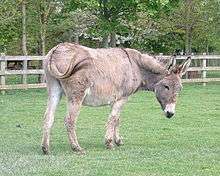Cotentin Donkey
The Cotentin Donkey, French: Âne du Cotentin, is a breed of domestic donkey from the Cotentin peninsula, in the département of la Manche, in the Lower Normandy region in north-west France. It is found mostly in that region, but is distributed through much of north-western France. It was in the past used as a pack animal in agricultural work, mainly for carrying milk churns; it is now used in leisure sports and tourism. The breed was recognised by the Ministère de l'Agriculture, the French ministry of agriculture, in 1997. The stud book is kept by the Association de l'âne du Cotentin, an association of breeders.
 | |
| Conservation status | |
|---|---|
| Other names | Âne du Cotentin |
| Country of origin | France |
| Distribution | north-west France |
| Standard | Ministère de l'Agriculture |
| Traits | |
| Height | |
| |
History
Donkeys are documented in the Cotentin from the 16th century.[4] In the 1930s there were 9000 donkeys in the Manche département. Numbers dwindled with the mechanisation of agriculture in the period after the Second World War, but less rapidly than in some other breeds, and in 1960 there were still 7000 in the Manche. A breeders' association, the Association de l’âne du Cotentin, was formed in 1995; since 1997, when the breed was officially recognised by the agriculture ministry and the Haras Nationaux, the association has kept the stud book for the breed.[5]
Cotentin donkeys are raised mainly in Lower Normandy, but are also found in more than half of French départements, mostly in north-west France.[6][7] Numbers were estimated at 650–700 in 2001.[4] In 2011 there were 107 breeders, and 140 new registrations in the stud book, approximately a quarter of all new donkey registrations in that year.[7]
Characteristics
The Cotentin Donkey measures 1.20–1.35 metres (47–53 in) for males, and 1.15–1.30 m (45–51 in) for females. The coat is dove grey, with a well-defined darker dorsal stripe and shoulder-stripe; the legs may show zebra-striping. The lower part of the muzzle is grey-white, as is the belly.[7]
Use
Like the Norman Donkey, the Cotentin Donkey was used in agricultural work, both as a pack animal to transport churns of milk in a time when cows were milked by hand in the field, and in harness.[4][8] Today it may be used as a pack animal for hiking or trekking, for recreational driving, in therapy for the handicapped, as a companion animal, or as a pet.[7][8] Asses' milk is used to make cold process soap.[9]
References
- Barbara Rischkowsky, D. Pilling (eds.) (2007). List of breeds documented in the Global Databank for Animal Genetic Resources, annex to The State of the World's Animal Genetic Resources for Food and Agriculture. Rome: Food and Agriculture Organization of the United Nations. ISBN 9789251057629. Accessed July 2014.
- Waltraud Kugler, Hans-Peter Grunenfelder, Elli Broxham (2008). Donkey Breeds in Europe: Inventory, Description, Need for Action, Conservation; Report 2007/2008. St. Gallen, Switzerland: Monitoring Institute for Rare Breeds and Seeds in Europe. Archived 2 September 2009.
- Marie-Hélène Le Henaff (8 January 2010). Annexe I: Standard de l'ane du Cotentin (in French). Annex to: Arrêté du 8 janvier 2010, Ministère de l’alimentation, de l’agriculture et de la pêche. In: Journal officiel "Lois et Décrets" 0018, 22 January 2010. Accessed July 2014.
- Serge Farissier (2007). L'âne du Cotentin (in French). In: L'âne. Editions Artemis. ISBN 9782844166425. p. 68.
- Historique de l'association (in French). Association de l'âne du Cotentin. Accessed July 2014.
- Lætitia Bataille (2008). Âne du Cotentin (in French). In: Races équines de France. France Agricole Éditions. ISBN 9782855571546. 247–250.
- Fiche de l'âne du Cotentin (in French). Haras nationaux Accessed July 2014.
- Erik Groult (1998). L'âne du Cotentin (in French). Patrimoine Normand 22 (August–September 1998). Accessed July 2014.
- Vente de savons au lait de nos anesses (in French). Association de l'âne du Cotentin. Accessed July 2014.